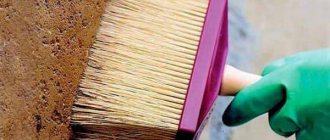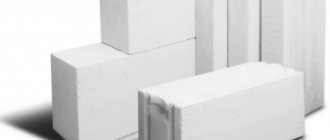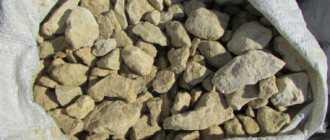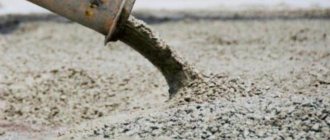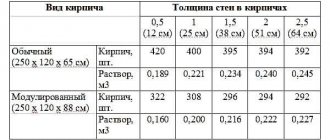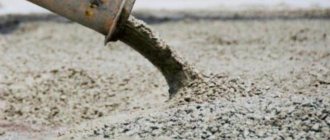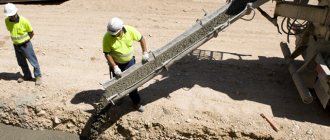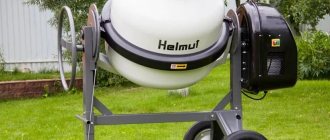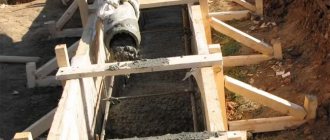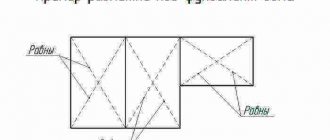Living in a private house, to save energy, I switched to heating with a pyrolysis boiler using wood. The result is obvious: in one heating season the boiler paid for itself by 42%. However, I immediately ran into the problem of calculating firewood. For one heating season I needed 5 dense cubic meters of firewood. Having calculated incorrectly, I took the firewood and in the middle of winter was forced to order an additional batch at a higher price, since the actual volume did not correspond. Therefore, I am sharing my experience on how to figure it out and understand how much 5 cubic meters of firewood is.
Source ytimg.com
How much does 1 cubic meter of steel weigh?
| Weight of a cube of metals, kg | |
| Aluminum | 2689 |
| Brass | 8200-8800 |
| Bronze | 7500-9100 |
| Steel | 7700-7900 |
Interesting materials:
How to soften the heel of leather shoes? How to soften a hard towel? How to mount an image into a virtual drive? How to watch VR video on HTC Vive? How to remove acrylic paint from furniture? How to remove acrylic paint from suspended ceilings? How to remove glue from a label? How to remove glue from fingers? How to remove dye from eyebrows after lamination? How to remove paint from a wooden surface?
Gas Density Table
Table of densities of liquefied propane-butane mixture (in t/m³) depending on its composition and temperature
| Propane/Butane ratio T, °C | −25 | −20 | −15 | −10 | −5 | 0 | 5 | 10 | 15 | 20 | 25 |
| 100/0 | 0,559 | 0,553 | 0,548 | 0,542 | 0,535 | 0,528 | 0,521 | 0,514 | 0,507 | 0,499 | 0,490 |
| 90/10 | 0,565 | 0,559 | 0,554 | 0,548 | 0,542 | 0,535 | 0,528 | 0,521 | 0,514 | 0,506 | 0,498 |
| 80/20 | 0,571 | 0,565 | 0,561 | 0,555 | 0,548 | 0,541 | 0,535 | 0,528 | 0,521 | 0,514 | 0,505 |
| 70/30 | 0,577 | 0,572 | 0,567 | 0,561 | 0,555 | 0,548 | 0,542 | 0,535 | 0,529 | 0,521 | 0,513 |
| 60/40 | 0,583 | 0,577 | 0,572 | 0,567 | 0,561 | 0,555 | 0,549 | 0,542 | 0,536 | 0,529 | 0,521 |
| 50/50 | 0,589 | 0,584 | 0,579 | 0,574 | 0,568 | 0,564 | 0,556 | 0,549 | 0,543 | 0,536 | 0,529 |
| 40/60 | 0,595 | 0,590 | 0,586 | 0,579 | 0,575 | 0,568 | 0,562 | 0,555 | 0,550 | 0,543 | 0,536 |
| 30/70 | 0,601 | 0,596 | 0,592 | 0,586 | 0,581 | 0,575 | 0,569 | 0,562 | 0,557 | 0,551 | 0,544 |
| 20/80 | 0,607 | 0,603 | 0,598 | 0,592 | 0,588 | 0,582 | 0,576 | 0,569 | 0,565 | 0,558 | 0,552 |
| 10/90 | 0,613 | 0,609 | 0,605 | 0,599 | 0,594 | 0,588 | 0,583 | 0,576 | 0,572 | 0,566 | 0,559 |
| 0/100 | 0,619 | 0,615 | 0,611 | 0,605 | 0,601 | 0,595 | 0,590 | 0,583 | 0,579 | 0,573 | 0,567 |
Distinctive features of liquefied gases:
- high vapor pressure;
- have no smell. To detect leaks in a timely manner, liquefied gases are given a specific odor - odorized with ethylmer-captan (C2H5SH);
- low temperatures and flammability limits. The ignition temperature of butane is 430°C, propane is 504°C. The lower flammability limit of propane is 2.3%, butane is 1.9%;
- propane, butane and their mixtures are heavier than air. In the event of a leak, liquefied gas can accumulate in wells or basements. It is prohibited to install equipment operating on liquefied gas in basement-type premises;
- transition to the liquid phase with increasing pressure or decreasing temperature;
- high calorific value. To burn LPG, a large amount of air is required (to burn 1 m³ of the gas phase of propane, 24 m³ of air is required, and butane - 31 m³ of air);
- large coefficient of volumetric expansion of the liquid phase (the coefficient of volumetric expansion of the liquid phase of propane is 16 times greater than that of water). Cylinders and tanks are filled to no more than 85% of their geometric volume. Filling more than 85% can lead to their rupture, subsequent rapid flow and evaporation of gas, as well as ignition of the mixture with air;
- as a result of evaporation of 1 kg of liquid phase of LPG at n. u. 450 liters of vapor phase is obtained. In other words, 1 m³ of the vapor phase of a propane-butane mixture has a mass of 2.2 kg;
- When 1 kg of propane-butane mixture is burned, about 11.5 kWh of thermal energy is released;
- liquefied gas evaporates intensely and, when it comes into contact with human skin, causes frostbite.
Example:
The density of a propane-butane mixture of 60% propane, 40% butane at an ambient temperature of -20°C will be 0.577 t/m3 or 577 kg/m3
Air density
The hot air inside this balloon is less dense than the surrounding air. This allows the ball to rise into the air and fly. Ruins of the ancient Mayan city of Teotihuacan, Mexico.
Just as in the case of water, bodies with a density lower than the density of air have positive buoyancy, that is, they take off. A good example of such a substance is helium. Its density is 0.000178 g/cm³, while the density of air is approximately 0.001293 g/cm³. You can see helium soar in the air if you fill a balloon with it.
The density of air decreases as its temperature increases. This property of hot air is used in balloons. The balloon in the photograph at the ancient Mayan city of Teotihuocan in Mexico is filled with hot air that is less dense than the surrounding cold morning air. That is why the ball flies at a fairly high altitude. While the ball flies over the pyramids, the air in it cools down and is heated again using a gas burner.
What is a cubic meter
A cubic meter is a unit of measurement of volume; in simple terms, it is how much substance can fit into a cube 1 meter wide, long and high. To understand how much 1 cubic meter of firewood is, imagine a box that is 1 meter in length, width and height, completely filled with wood without gaps - this is an ideal cubic meter of firewood in the real volume of firewood.
Source infradom.ru
We measure cubic meter
Let's start with the fact that there are three types of firewood volume:
- Navalny
- folding
- real (we have already dealt with it - solid wood without empty spaces)
If we explain in simple words what bulk and folded volume is, then the seller will conditionally bring you firewood either randomly scattered (bulk) in the back, or neatly folded (folded).
Almost all wood sellers, when talking about selling 5 cubic meters of firewood, mean 5 cubic meters of firewood in bulk, which is far from the real volume.
So, to calculate the cubic capacity of firewood, you need to calculate the folded volume (the volume of wood if it is folded). And to do this, we first measure the volume of the car body in which the wood was brought: we measure the width, length and height of the body, then multiply.
Let's determine the volume of firewood for the ZIL-130-554 body, which is quite often used for transporting firewood.
Source kolyan22rus.myjino.ru
The volume of the body is almost 5.5 cubic meters (3.752 m - length, 2.5 m - width, 0.575 m - height; 3.752 * 2.5 * 0.575 = 5.4 m³), and with a slide, as in photo, you can safely count all 6 cubic meters.
Next, you need to multiply the resulting volume of the body by a coefficient that depends on the wood itself and the length of the firewood or logs. Almost all wood sellers in their work use an average coefficient of 0.7 (if the firewood is not chopped, then they use an average coefficient of 0.6, since when stacked in chocks or logs, the density and, accordingly, the volume itself decreases).
That is, conditionally, if you ordered 5 cubic meters of firewood, and they were delivered in the bulk volume of the body, then when you fold them, they will take up only 3.5 cubic meters (5 m³ * 0.7 = 3.5 m³).
And, in order to calculate the real volume of wood, you need to multiply the resulting folded volume by the coefficient for converting the folded measure into a dense one, here you need to calculate the length of the firewood (logs).
Let’s take the same 5 cubic meters of firewood in bulk that you ordered. Their folded volume is 3.5 cubic meters, and the length of firewood is on average 30-40 centimeters; the coefficient for such firewood according to GOST is 0.74. We multiply 3.5 m³ * 0.74 and get almost 2.6 cubic meters.
All coefficients and additional information are specified in GOST 3243-88.
Source cntd.ru
That is, out of the 5 cubic meters of wood you purchased, the actual volume will be only 2.6 m³. The good news is that all this is taken into account in prices - a cube of solid wood will be 2-2.5 times more expensive than a cube of round wood.
For those who do not want to calculate all this themselves, many sites selling firewood have online calculators for measuring the cubic capacity of chopped firewood; finding them will not be difficult.
Density and mass
Airplanes often use composite materials instead of pure metals, since, unlike metals, such materials have high elasticity and low weight. The propellers of this Bombardier Q400 aircraft are made entirely of composite materials.
Some industries, such as aviation, require materials that are as light as possible. Since low-density materials also have low mass, in such situations they try to use materials with the lowest density. For example, the density of aluminum is only 2.7 g/cm³, while the density of steel is from 7.75 to 8.05 g/cm³. It is due to the low density that 80% of aircraft bodies use aluminum and its alloys. Of course, one should not forget about strength - today few people make airplanes from wood, leather, and other lightweight but low-strength materials.
Airplanes often use composite materials instead of pure metals, since, unlike metals, such materials have high elasticity and low weight. The propellers of this Bombardier Q400 aircraft are made entirely of composite materials.
An artistic depiction of a black hole by NASA.
Density of water
If the density of the material from which the object is made is greater than the density of water, then it is completely immersed in water. Materials with a density lower than that of water, on the contrary, float to the surface. A good example is ice, which is less dense than water, floating in a glass on the surface of water and other drinks that are mostly water. We often use this property of substances in everyday life. For example, when constructing ship hulls, materials with a density higher than the density of water are used. Since materials with a density higher than the density of water sink, air-filled cavities are always created in the ship's hull, since the density of air is much lower than the density of water. On the other hand, sometimes it is necessary for an object to sink in water - for this purpose, materials with a higher density than water are chosen. For example, in order to sink light bait to a sufficient depth while fishing, anglers tie a sinker made of high-density materials, such as lead, to the fishing line.
The density of fat is lower than the density of water, so it is easy to remove from the surface of soups, especially those cooled in the refrigerator to the temperature where the fat solidifies. It is convenient to remove them from both aspic and aspic, as in the photo. Photo published with permission of the author.
Oil, grease and petroleum remain on the surface of the water because their density is lower than that of water. Thanks to this property, oil spilled in the ocean is much easier to clean up. If it mixed with water or sank to the seabed, it would cause even more damage to the marine ecosystem. This property is also used in cooking, but not of oil, of course, but of fat. For example, it is very easy to remove excess fat from soup as it floats to the surface. If you cool the soup in the refrigerator, the fat hardens, and it is even easier to remove it from the surface with a spoon, slotted spoon, or even a fork. In the same way it is removed from jellied meat and aspic. This reduces the calorie content and cholesterol content of the product.
Information about the density of liquids is also used during the preparation of drinks. Multilayer cocktails are made from liquids of different densities. Typically, lower-density liquids are carefully poured onto higher-density liquids. You can also use a glass cocktail stick or bar spoon and slowly pour the liquid over it. If you take your time and do everything carefully, you will get a beautiful multi-layered drink. This method can also be used with jellies or jellied dishes, although if time permits, it is easier to chill each layer separately, pouring a new layer only after the bottom layer has set.
The cherry tomato floats on the boundary between the pink-colored salt water below and the lower-density fresh water above. The density of a tomato is greater than the density of pure water and less than the density of salt water, which is why it ended up in the middle.
In some cases, the lower density of fat, on the contrary, interferes. Products with a high fat content often do not mix well with water and form a separate layer, thereby deteriorating not only the appearance, but also the taste of the product. For example, in cold desserts and smoothies, high-fat dairy products are sometimes separated from low-fat dairy products such as water, ice and fruit.
Density of salt water
The cherry tomato floats on the boundary between the pink-colored salt water below and the lower-density fresh water above. The density of a tomato is greater than the density of pure water and less than the density of salt water, which is why it ended up in the middle.
The density of water depends on the content of impurities in it. In nature and in everyday life, pure H2O water without impurities is rarely found - most often it contains salts. A good example is sea water. Its density is higher than that of fresh water, so fresh water usually “floats” on the surface of salt water. Of course, it is difficult to see this phenomenon under normal conditions, but if fresh water is enclosed in a shell, for example in a rubber ball, then this is clearly visible, since this ball floats to the surface. Our body is also a kind of shell filled with fresh water. We are made up of 45% to 75% water - this percentage decreases with age and as we gain weight and body fat. Fat content of at least 5% of body weight. Healthy people have up to 10% body fat if they exercise a lot, up to 20% if they are of normal weight, and 25% or more if they are obese.
If we try not to swim, but simply float on the surface of the water, we will notice that it is easier to do this in salt water, since its density is higher than the density of fresh water and the fat contained in our body. The Dead Sea's salt concentration is 7 times the average salt concentration in the world's oceans, and it is famous around the world for allowing people to easily float on the surface of the water without drowning. Although, it is a mistake to think that it is impossible to die in this sea. In fact, people die in this sea every year. The high salt content makes the water dangerous if it gets into your mouth, nose, or eyes. If you swallow such water, you can get a chemical burn - in severe cases, such unlucky swimmers are hospitalized.
Density calculation
Often the density of substances is indicated for standard conditions, that is, for a temperature of 0 °C and a pressure of 100 kPa. In educational and reference books you can usually find such densities for substances that are often found in nature. Some examples are shown in the table below. In some cases, the table is not enough and the density must be calculated manually. In this case, the mass is divided by the volume of the body. The mass can be easily found using a scale. To find out the volume of a body of a standard geometric shape, you can use formulas to calculate volume. The volume of liquids and solids can be found by filling a measuring cup with the substance. For more complex calculations, the liquid displacement method is used.
Liquid displacement method
To calculate the volume in this way, first pour a certain amount of water into a measuring vessel and place the body whose volume needs to be calculated until it is completely immersed. The volume of a body is equal to the difference in the volume of water without the body and with it. It is believed that this rule was derived by Archimedes. Volume can be measured in this way only if the body does not absorb water and does not deteriorate from water. For example, we will not measure the volume of a camera or fabric product using the liquid displacement method.
It is unknown to what extent this legend reflects actual events, but it is believed that King Hiero II gave Archimedes the task of determining whether his crown was made of pure gold. The king suspected that his jeweler had stolen some of the gold allocated for the crown and instead made the crown from a cheaper alloy. Archimedes could easily determine this volume by melting the crown, but the king ordered him to find a way to do this without damaging the crown. It is believed that Archimedes found the solution to this problem while taking a bath. Having immersed himself in water, he noticed that his body had displaced a certain amount of water, and realized that the volume of displaced water was equal to the volume of the body in the water.
Hollow bodies
Some natural and man-made materials are composed of particles that are hollow, or particles so small that they behave like liquids. In the second case, an empty space remains between the particles, filled with air, liquid, or other substance. Sometimes this place remains empty, that is, it is filled with a vacuum. Examples of such substances are sand, salt, grain, snow and gravel. The volume of such materials can be determined by measuring the total volume and subtracting from it the volume of voids determined by geometric calculations. This method is convenient if the shape of the particles is more or less uniform.
For some materials, the amount of empty space depends on how tightly the particles are packed. This complicates calculations because it is not always easy to determine how much empty space there is between particles.
Table of densities of substances commonly found in nature
| Substance | Density, g/cm³ |
| Liquids | |
| Water at 20°C | 0,998 |
| Water at 4°C | 1,000 |
| Petrol | 0,700 |
| Milk | 1,03 |
| Mercury | 13,6 |
| Solids | |
| Ice at 0°C | 0,917 |
| Magnesium | 1,738 |
| Aluminum | 2,7 |
| Iron | 7,874 |
| Copper | 8,96 |
| Lead | 11,34 |
| Uranus | 19,10 |
| Gold | 19,30 |
| Platinum | 21,45 |
| Osmium | 22,59 |
| Gases at normal temperature and pressure | |
| Hydrogen | 0,00009 |
| Helium | 0,00018 |
| Carbon monoxide | 0,00125 |
| Nitrogen | 0,001251 |
| Air | 0,001293 |
| Carbon dioxide | 0,001977 |

